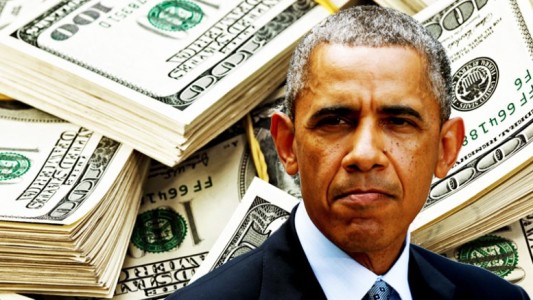That would be close to a doubling of the debt under Obama — the total national debt was $10.6 trillion when he took office in 2009, and now sits at nearly $18.1 trillion.
CBO released its latest budget and economic outlook on Monday, which also predicts that the annual budget deficit will be relatively steady through 2018, and then spike to even higher levels if there are no changes to the law.
Through 2018, the budget deficit will remain at around $500 to $600 billion a year, or about 2.5 percent of the gross domestic product of the United States. After 2018, however, the budget deficit will rise past 3 percent of GDP, and then hit 4 percent of GDP by 2025.
By 2025, those accumulated annual budget deficits will bring total national debt to an estimated $27.3 trillion without any changes to the law.
Obama has boasted about the shrinking of the budget deficit from the more than $1 trillion seen in the first four years of his presidency. But even with that reduction, budget deficits under Obama are on track to stay higher than the highest deficit seen under President George W. Bush.
CBO’s assumptions are based on relatively rosy scenarios that would be easily upended by another economic downturn. For example, CBO predicts 2.9 percent growth in 2015 and 2016, followed by 2.5 percent growth in 2017. It predicts an average of 2.1 percent growth from 2018-2019 and 2020-2025.
Those predictions of steady economic growth are the basis for CBO’s predictions of steadily increasing tax revenue, something that hasn’t always come true in past estimates. The government took in 3.02 trillion in 2014, and CBO thinks that number will rise evenly until it hits $3.72 trillion by 2018.
By 2025, CBO expects federal revenues to jump $2 trillion fro their 2014 levels, and that the government will take in $5 trillion that year.
In terms of spending, CBO thinks the government will be spending $6.1 trillion per year in 2025, or $2.6 trillion more than it spent in 2014.
Total national debt is usually split into debt held by the public, and debt in the form of “intragovernmental holdings,” which is essentially money the government took from one program to pay for another that it still owes to itself.
CBO estimates that by 2016, total debt held by the public will be $13.9 trillion, which implies intragovernmental holdings of about $5.2 trillion. Debt held by the public in 2025 will hit $21.6 trillion, according to CBO.
Source: The Blaze
 The Congressional Budget Office is predicting that the national debt will rise by a bit more than half a trillion dollars for the next two years, which will leave the nation with a $19.1 trillion debt by the time President Barack Obama leaves office.
The Congressional Budget Office is predicting that the national debt will rise by a bit more than half a trillion dollars for the next two years, which will leave the nation with a $19.1 trillion debt by the time President Barack Obama leaves office.

